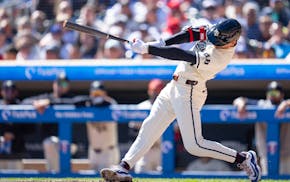Minnesota Vikings center Pat Elflein (65) waits for a play to begin against the Chicago Bears during the second half of an NFL football game, Monday, Oct. 9, 2017, in Chicago. (AP Photo/Darron Cummings)
Through seven games in the 2017 regular season, the Vikings have used eight linemen, with their five starters missing only a combined two games and their three backups playing just 176 snaps.
At this point last season, the Vikings had already fielded 10 different linemen. Three of them had started at left tackle, and the five players who weren't among the Vikings' opening day starters had already played 738 snaps.
The first real test of the Vikings' line depth came on Sunday, when Rashod Hill stepped in for Riley Reiff at left tackle and rookie Danny Isidora came in at left guard when Jeremiah Sirles (who was already filling in for the injured Nick Easton) left with a sprained knee. But the Vikings could get Reiff and Easton back on Sunday, and their offensive line play didn't drop off noticeably when they had to use their backups against the Ravens.
"Rashod [Hill] went in and did fine," coach Mike Zimmer said. "There's still a lot of things we've got to clean up. His footwork and some things. Same thing with [Danny] Isidora. So we all get on the same deal. But they went in there and battled, competed."
The Vikings invested in what they hoped would be a more stable offensive line before this season, and through seven games, that stability is perhaps the biggest reason to think this year's 5-2 start could be more sustainable than last year's record. By this point in 2016, the Vikings had already dropped two straight games after a 5-0 start, while using a rotation of three different players at their two tackle spots in what turned out to be Norv Turner's final two games as offensive coordinator. This year, they've mostly had their starters, and the group has played impressively as a whole.
Football Outsiders ranked the Vikings' pass protection as the fourth-best in the NFL, with an adjusted sack rate of just 3.8 percent of pass attempts. And while the group is only 20th in adjusted line rushing yards, it finished 30th a year ago. In every metric the site tracks — effectiveness on power runs, infrequency of stuffed rush attempts, ability to get running backs to the second level and success on open-field rushes — the Vikings are better than they were last year.
"I think the running game has helped us tremendously in things we're able to do as compared to a year ago," Zimmer said. "We did have a couple negative runs in the red zone but we're not getting very many of those. We're getting yards. I do think they've done a nice job with the scheme as far as, we've got perimeter runs, we've got inside runs, we've got power football runs. I think all those things have helped."
The Vikings' next two games are against run defenses ranked among the league's top 10, but from rookie Pat Elflein to right guard Joe Berger — who entered the season with one more year of experience than the rest of the starters combined — the starting five has functioned well together.
"They're just solid in everything they do. Mike Remmers played well, Riley [Reiff] played well, [Pat] Elflein. These guys, [Danny] Isidora when he went in there played well, [Joe] Berger," Zimmer said. "They're playing good together. They're all on the same page. You see the footwork is the same. Everything kind of looks like it's supposed to. We were able to open up some holes. I think they're playing good."
What's more, the members of the starting offensive line have largely been available to the Vikings every week. The team's biggest liability a year ago has become a central part of its foundation this year.

Live: Minnesota United at Charlotte FC. Follow on Gameview.
Jameson Taillon comes off the injured list and helps the Cubs beat the Marlins 8-3
T-wolves take NBA's best defense into series vs. Suns, but can it stop Durant-Booker-Beal trio?

